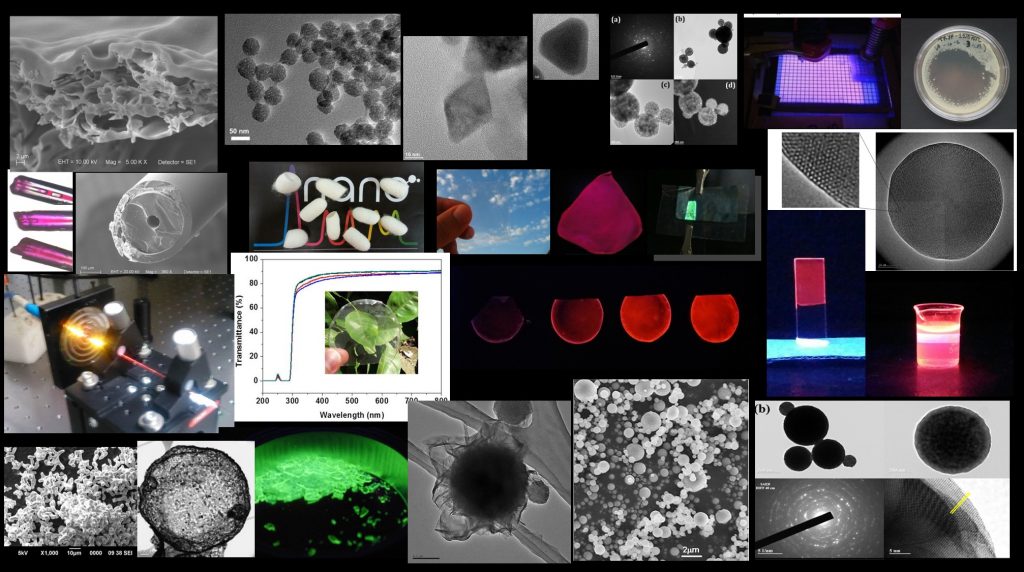Menu
Menu
Research
The research developed in the Nanomaterials and Luminescent Systems Group (NanoLum) is a consequence of continuous evolution, and the focus of research today is wide, but always aiming at luminescent nanostructured systems. Ongoing projects aim to study emission processes via mechanisms such as Downshifting, Upconversion and Downconversion. In addition, the synthesis of particles by spray pyrolysis provides the study of materials for Laser emission in a random environment. Thus, the group works on the synthesis of nano and sub microparticulate inorganic materials with control of the crystal structure to explore the luminescent properties of lanthanide ions, such as alumina, silica, titania, YAG, fluorides, molybdates, and borates; the research has also been carried out in matrices of biological origin, such as bacterial cellulose and fibroin (silk protein extracted from the cocoons of the silkworm, Bombyx mori), always aiming for new devices for emitting light, whether in ultraviolet, visible, or infrared.

To better describe the developed projects, the common objectives that permeate the different projects are presented:

1°) Light converting materials
A wide range of inorganic matrices, such as alumina (in different crystalline phases), silica, titania, YAG, fluorides, phosphates, molybdates, and borates are continuously prepared by different methodologies and doped with lanthanide ions such as Eu3+, Nd3+, Pr3+, Tb3+, Er3+, Yb3+, and Tm3+, with an extensive study of the emission mechanisms involved, mainly for downshifting and upconversion, with different spectral range from the ultraviolet, passing through the visible and up to near infrared.

2°) Sensors
Currently, the group develops the synthesis of matrices such as YAG, YAM and YAB doped with Nd3+ with the objective of producing luminescent nano and sub-micro-particulate thermometers. YAG and YAB doped with Er3+ or with Yb3+/Er3+ were also obtained and studies of the thermometric response via upconversion mechanism are ongoing. The development of luminescent materials to act as a gas sensor is one of our focuses of studies; and the basis of this work are silica and alumina aerogels doped with rare-earth ions, as well as fibroin composite films and complexes of Eu3+ ion.

3°) Luminescent composite materials
The group is active in the preparation and structural study of composites doped with lanthanide ions involving matrices of biological origin, such as bacterial cellulose, gellan gum, and fibroin (silk protein extracted from silkworm cocoons, Bombyx mori), to obtain new materials for application in photonics. The main characteristic of the composites obtained is the high mechanical strength combined with flexibility and transparency in the visible and near-infrared spectral region. In this subproject, there is also work for the development of a luminescent biocompatible composite to be used in a 3D printer.

4°) Laser in a random environment
Different works are in progress to study laser emission in a random environment, mainly in inorganic matrices doped with lanthanide ions obtained by the spray pyrolysis methodology, or porous matrices via template synthesis. This objective overlaps with obtaining composites with fibroin, aiming to find the best conditions for light confinement in the amplifier medium and an ideal ratio between the activator and scattering medium.

5) Plasma-assisted synthesis of metallic nanoparticles
In collaboration with French colleagues, we have developed the synthesis of gold or silver nanoparticles in solution, by the action of helium plasma. Currently, a project is ongoing for the systematic study of the synthesis of different metallic particles (Ag, Au) by the reducing action of plasma in solution, aiming to control the size and, also, a possible synthesis of AuNPs on the surface of lanthanide-doped fluoride nanoparticles.

